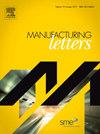Flow analysis and fabrication of micro scale controlled surfaces by ultrashort pulse laser for microfluidic device applications
IF 1.9
Q3 ENGINEERING, MANUFACTURING
引用次数: 0
Abstract
Microfluidics finds a wide range of industrial applications mainly in fields such as biomedical, clinical, electrical, and thermal engineering. Microchannels are the building blocks of most microfluidic devices. Thus, it becomes evident to understand the properties and the effect of the surfaces on the outcomes of devices. In this study, the effect of the shape of microchannels and the roughness elements on the flow is evaluated. Microchannels with three cross-sections and roughness elements of three different geometries are considered. The effect of varying Reynolds numbers on the flow parameters such as Friction factor, Nusselt number, Poiseuille number, pressure drop and surface temperature at the base of the substrate is studied. It is observed that rough microchannels and rectangular roughness elements showed a higher Nusselt number than smooth microchannels. The rough microchannels with triangular roughness elements showed higher friction factors. The surface temperature is higher for the smooth microchannels with triangular roughness elements. Furthermore, to demonstrate the manufacturability of microfluidic channels with controlled surfaces and to validate the preliminary results of the numerical simulations, the ultrashort pulse laser micromachining technique is used to fabricate the microchannels with structures on Polymethyl Methacrylate (PMMA) material.
利用超短脉冲激光进行流动分析和制造微尺度可控表面,用于微流体设备应用
微流体技术主要在生物医学、临床、电气和热能工程等领域有着广泛的工业应用。微通道是大多数微流体设备的组成部分。因此,了解表面的特性及其对设备结果的影响就显得尤为重要。本研究评估了微通道的形状和粗糙度元素对流动的影响。研究考虑了三种截面的微通道和三种不同几何形状的粗糙元件。研究了不同雷诺数对流动参数的影响,如摩擦因数、努塞尔特数、波瓦数、压降和基底表面温度。结果表明,粗糙微通道和矩形粗糙度元素比光滑微通道显示出更高的努塞尔特数。带有三角形粗糙元素的粗糙微通道显示出更高的摩擦系数。带有三角形粗糙度元件的光滑微通道的表面温度更高。此外,为了证明具有可控表面的微流体通道的可制造性,并验证数值模拟的初步结果,使用超短脉冲激光微加工技术在聚甲基丙烯酸甲酯(PMMA)材料上制造了具有结构的微通道。
本文章由计算机程序翻译,如有差异,请以英文原文为准。
求助全文
约1分钟内获得全文
求助全文
来源期刊

Manufacturing Letters
Engineering-Industrial and Manufacturing Engineering
CiteScore
4.20
自引率
5.10%
发文量
192
审稿时长
60 days
 求助内容:
求助内容: 应助结果提醒方式:
应助结果提醒方式:


